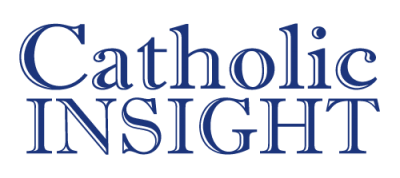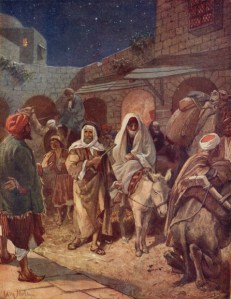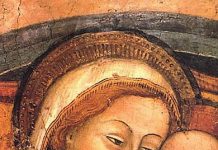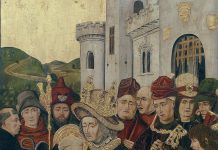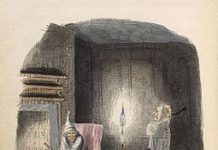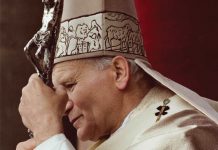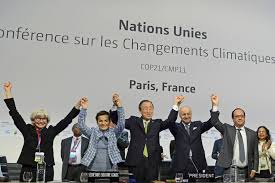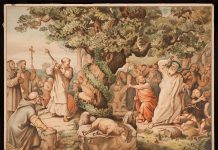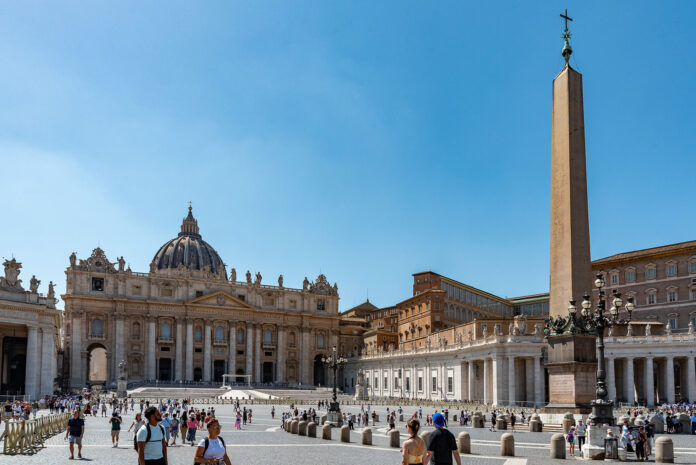
(On this feast of Saint Matthias – whom we may see as the patron saint of good choices – here is a fine reflection by Joseph Donnelly on the providential election of Pope Leo, with many intriguing connections to saints and prophecies…We will see!)
The moral imperative to pray for the pope
A recent article of mine attempted to destroy the idol which seductively whispered that the Holy Spirit actively and infallibly chooses each pope during a conclave. The primary motive in doing so was to demonstrate the grave duty to pray for the Sacred College of Cardinals. With the election of Robert Francis Prevost as Leo XIV, however, the role of the faithful is far from over. On the contrary, as Raymond Cardinal Burke wrote on the very day Papa Prevost was elected, we must “pray fervently for Pope Leo XIV” that God “will grant him abundant wisdom, strength, and courage to do all that Our Lord is asking of Him in these tumultuous times.” In her memoirs, Mother Pascalina Lenhert records the following conversation of Venerable Pius XII and a “dear acquaintance” from 1957, eighteen years into the holy pope’s papacy:
“People do not think enough about the enormous responsibility that forty years as a bishop–the fullness of the priesthood–places on one’s shoulders. Pray for me, I tremble before being called to account.”
“Your Holiness,” came the reply, “if you talk like that, then who can stand the test?”
“Believe me,” Pius XII answered, “the responsibility of a Pope is gigantic!”[1]
The guilt-laden question we should all ask ourselves is this: How much do we actually pray for our Holy Father? Without giving way to unhealthy self-criticism, let alone despair, I believe I can realistically say that I did not intentionally pray for Pope Francis nearly as much as I ought. Of course, one should not be scrupulous about forgetting to pray for this or that intention. God knows our hearts better than we do. Moreover, when one is consecrated to Our Lady, it is said that one gives Our Lady full right as to what our prayers and good works are applied. As St. Maximilian Kolbe prayed in his beautiful act of consecration to Our Lady, “Please make of me, of all my powers of soul and body, of my whole life, death and eternity, whatever pleases you.”
It seems, nevertheless – to borrow the phraseology of the second book of Maccabees – “a holy and wholesome thought” to recall particular intentions when praying. I cannot help but internally shudder at the words of Our Lady to the Fatima children that many souls go to hell because no one prays for them. I wonder if something similar could be said about popes, namely, that many popes struggle or fail in this or that aspect of their pontificate because the faithful do not adequately pray for them.
Signs from Our Lady?
Thanks be to God, there have been various calls from clergy and laymen alike asking all Catholics to pray for the new pope. Some of the messages have a tone of urgency, reinforced by historical reflections. Gerhard Cardinal Müller mentioned two rather infamous, albeit different, predecessors of Papa Prevost: Martin Luther (who, before his apostasy, was an Augustinian friar, like Leo XIV) and Pope Leo X, who tragically failed to address Luther’s 1517 revolt (as well as the proximate causes), let alone live up to the standards expected of a pope. It is interesting to note that May 6th, the day before the conclave began, was the anniversary of the 1527 sack of Rome. This took place during the reign of Pope Clement VII, another unfortunate pope, and a cousin of Leo X.
Roberto de Mattei recalled more recent events occurring four hundred years after Luther’s revolt: The 1917 apparitions of Our Lady at Fatima. Mattei first quotes Leo XIV’s inaugural homily, which contains a striking reflection regarding St. Ignatius of Antioch:
Saint Ignatius, who was led in chains to this city [Rome], the place of his impending sacrifice, wrote to the Christians there: “Then I will truly be a disciple of Jesus Christ, when the world no longer sees my body” (Letter to the Romans, IV, 1). Ignatius was speaking about being devoured by wild beasts in the arena – and so it happened – but his words apply more generally to an indispensable commitment for all those in the Church who exercise a ministry of authority. It is to move aside so that Christ may remain, to make oneself small so that he may be known and glorified (cf. Jn 3:30), to spend oneself to the utmost so that all may have the opportunity to know and love him.
Mattei comments:
These words sound almost like an omen. In his first appearance on the loggia of St. Peter’s Basilica, Leo XIV’s face was streaked with a few tears. These discreet tears can express the emotion of a man who in front of a cheering crowd reviews his entire past, from the Chicago parish to his unexpected landing at the top of the Church. But they can also manifest the affliction of one who glimpses the future of the Church and the world.
How can we fail to recall the silent and prophetic weeping of Our Lady in Syracuse, where Cardinal Prevost went in September last year, on the 71st anniversary of the miraculous tearing? And how can we fail to recall, on the eve of May 13, the Third Secret of Fatima, which describes a Pope, “afflicted with grief and sorrow,” passing through a city in ruins, ascending to a mountain where martyrdom awaits him at the foot of the Cross?
The future of Pope Leo XIV is known only to God, but the message of Fatima, with its promise of the final triumph of the Immaculate Heart of Mary is a certainty that animates devout hearts in these astonishing days of May that have given a new Pope to the Church.
Thought-provoking observations, to say the least. One is reminded of Benedict XVI’s May 13th pronouncement at Fatima, fifteen years ago: “We would be mistaken to think that Fatima’s prophetic mission is complete.” He concluded his sermon, as Mattei did in his recent article, with a hopeful mention of Our Lady’s promised triumph:
At a time when the human family was ready to sacrifice all that was most sacred on the altar of the petty and selfish interests of nations, races, ideologies, groups and individuals, our Blessed Mother came from heaven, offering to implant in the hearts of all those who trust in her the Love of God burning in her own heart… May the seven years which separate us from the centenary of the apparitions hasten the fulfillment of the prophecy of the triumph of the Immaculate Heart of Mary, to the glory of the Most Holy Trinity
It seems that Our Lady may be trying hard to grab our attention to pray for Leo XIV. His May 8th election was but days before the anniversary of the first Fatima apparition on May 13th. On May 10th he made a “surprise excursion” just outside Rome to the Augustinian Shrine of the Mother of Good Counsel. Less than a year ago, as noted by Mattei, he visited the “Weeping Madonna of Syracuse”, seventy-one years after the miraculous phenomenon of 1953. Finally, Leo XIV himself reminded (or, indeed, informed) us in his first public address that his election took place on “the day of the Prayer of Supplication to Our Lady of Pompeii.” The origin of this prayer is briefly explained in a footnote of St. John Paul II’s 2002 apostolic letter Rosarium Virginis Mariae: “The Supplication to the Queen of the Holy Rosary was composed by Blessed Bartolo Longo in 1883 in response to the appeal of Pope Leo XIII, made in his first Encyclical on the Rosary, for the spiritual commitment of all Catholics in combating social ills. It is solemnly recited twice yearly, in May and October.”
It should be noted that Pope Francis, during his stay in Gemeli hospital, approved the canonization of Blessed Bartolo. John Paul II in Rosarium Virginia Mariae, showers praise on Bartolo and recalls his founding of the shrine to Our Lady at Pompeii:
As a true apostle of the Rosary, Blessed Bartolo Longo had a special charism. His path to holiness rested on an inspiration heard in the depths of his heart: “Whoever spreads the Rosary is saved!”. As a result, he felt called to build a Church dedicated to Our Lady of the Holy Rosary in Pompei, against the background of the ruins of the ancient city, which scarcely heard the proclamation of Christ before being buried in 79 A.D. during an eruption of Mount Vesuvius, only to emerge centuries later from its ashes as a witness to the lights and shadows of classical civilization. By his whole life’s work and especially by the practice of the “Fifteen Saturdays”, Bartolo Longo promoted the Christocentric and contemplative heart of the Rosary, and received great encouragement and support from Leo XIII, the “Pope of the Rosary”.
St. Michael and Leo XIII
As many have noted, May 8th is also the feast of the apparition of St. Michael the Archangel on Mount Gargano, though it is by no means a coincidence. Bartolo writes of this in his History of the Sanctuary of Pompei. He insisted that the “solemn consecration and laying of the cornerstone of the Temple of Pempei” occur on May 8th, “as it is the day sacred to the Archangel Saint Michael.” He further writes: “But this choice of a day sacred to the apparition of the Archangel of God… did not only arise from a feeling of deep devotion for this noble Spirit of Heaven, but really from a higher reason.” The apparition to which he refers took place in the 600s on what was known as Mount Gauro. Important to Bartolo was the mountain’s visibility from the valley of Pompeii. “The Archangel Saint Michael”, he continued, “appeared to the Bishop of Castellammare [St. Catello], and told him to build a church in his honor on the summit of that mountain, on the spot which he would indicate by the apparition of a flame. And the flame appeared on the highest point of the three peaks of Mount Gauro.” [2]
This apparition of St. Michael reminds one of the “Angel with a flaming sword” yelling “Penance! Penance! Penance!” described by Sister Lucia in “The third part of the secret revealed at the Cova da Iria-Fatima, on 13 July 1917.” Moreover, the St. Michael prayer was published by Pope Leo XIII, in whose honour Papa Prevost chose his papal name. As Bishop Athanatius Schneider writes in his foreword to Kevin Symonds’s investigative book Pope Leo XIII and the Prayer to St. Michael:
At the threshold of the 20th century, a century of unheard militant atheism and anti-human monstrous political regimes, Pope Leo XIII gave to the Church the famous prayer to Saint Michael the Archangel, which he ordered to be recited worldwide by each priest and the faithful after a non-chanted Mass. The same Pope gave a very powerful prayer of general exorcism against the infestations of Satan and the evil spirits. This exorcism could be recited by a priest with the permission of his Ordinary. Pope Leo XIII himself recited this exorcism several times during the day.[3]
How beautiful it is that Leo XIV, providentially elected on May 8th, assumed the name of such a pope who also supported Blessed Bartolo in his Marian apostolate at Pompeii! Do we require any further convincing to earnestly implore Our Lady to keep Leo XIV in her protective embrace and St. Michael to drive from him all attacks of the devil?
A Hungarian Connection?
There is, yet, one more possible hint from heaven which, while less certain than what has been described thus far, seems too coincidental to ignore. It recently occurred to me that May 9th is the birthday of the Servant of God Zita of Bourbon-Parma, wife of Blessed Karl von Habsburg (emperor of Austria and apostolic king of Hungary). On this past May 9th, the day following the papal election, Leo XIV celebrated his first mass as pope with the college of cardinals and preached his previously quoted homily. “Is there any significance to this correlation?”, thought I.
In my article regarding the conclave, I noted that the 50th anniversary of the death of Venerable József Cardinal Mindszenty, the formidable Primate of Hungary, was on May 6th, the day before the conclave. At a time when all the cardinals, especially the electors, had to put aside human considerations and fears, it seemed appropriate to recall the words of Pius XII to Mindszenty in 1946: “Among these thirty-two [new cardinals] you will be the first to suffer the martyrdom symbolized by this red color.” [4] Whether Mindszenty is declared a confessor for the faith (and thus called a “white martyr”) or legally judged to truly be a martyr (if his torture and imprisonment significantly contributed to his decline and death), it is unreasonable to hold that Pius XII’s statement was not prophetic. His words linger in my mind after having read Leo XIV’s reflection on St. Ignatius of Antioch: “Ignatius was speaking about being devoured by wild beasts in the arena – and so it happened – but his words apply more generally to an indispensable commitment for all those in the Church who exercise a ministry of authority. It is to move aside so that Christ may remain”.
Mindszenty and Zita were both born in 1892. Fifty-three years ago, Mindszenty was invited to celebrate Zita’s 80th birthday in May 1972. One of her grandchildren, Princes Maria-Anna Galitzine, writes the following regarding that occasion: “I remember my grandmother speaking with him in fluent Hungarian. They were both very happy. They had a lot of common memories. He was a very young chaplain when he participated in the crowning of King Karl in Budapest in 1916.”
In his memoirs, Mindszenty writes of Pius XII’s attendance of the 1938 International Eucharistic Congress in Hungary before he became pope: “[S]ince that time [he] had been warmly disposed toward us.”[5] Leo XIV has also visited Hungary, first as bishop of Chicalyo, Peru, for the 2021 International Eucharist Congress and then as prefect of the Dicastery for bishops during Pope Francis’s apostolic visit in 2023. Daily News Hungary reports the congratulatory message to Leo XIV by Bishop András Veres, President of the Hungarian Catholic Bishops’ Conference, which certainly reminds one of Mindszenty’s words regarding Pius XII: “The letter noted that the new pontiff already visited Hungary at the time of Pope Francis’s visit, becoming acquainted with ‘our people and culture’, adding hopefully he would pay another visit.” Indeed, St. Leo IX was the only pope to visit Hungary as pope before John Paul II did so in 1991, as explained by the Hungarian Conservative in 2023:
A few decades after the foundation of the Kingdom of Hungary, the first papal visit to the country took place, which must not have been an easy trip to make back then. The later canonised Pope Leo IX of Alsatian descent arrived on Hungarian soil for the first time in 1052 as a peace facilitator. At the time, not for the first time or the last time, tension arose between the Holy Roman Empire and Hungary, thus the Pope decided to act as a mediator between Emperor Henry III and King Andrew I of Hungary, for which he personally visited the conflicting sides near the city of Pressburg (today’s Bratislava.)
Pius XII never visited Hungary as pope but, as Archbishop Pacelli and envoy of Pope Benedict XV, he did meet with Blessed Karl during the attempt to obtain a swift and just peace during World War I. Benedict XV himself consecrated Pacelli on May 13, 1917, the very day of the first apparition at Fatima. Tragically, neither the Allied powers nor the German government were receptive to the efforts of pope, king, and nuncio. Pius XII was hardly more successful with the Allies during World War II. Nevertheless, just as Blessed Karl is called the “Peace Emperor” for his conduct during World War I, so too was Pius XII hailed the “Pope of Peace” for his words and actions during the Second World War and the resulting Cold War. His episcopal motto, Opus Justitiae Pax, may be translated as “The work of justice is peace” or “Peace is the work of justice”.
In his inaugural Regina Caeli address on Sunday, May 11, Leo XIV earnestly called for peace and did not hesitate to mention various conflicts by name. “But how many other conflicts there are in the world!”, he lamented. How strange it seems that the 80th anniversary of World War II’s end, which was also noted by Leo XIV, was the very same day he was elected pope. This, yet again, hearkens back to Zita, as one biography of Karl and Zita relates, “In 1945 Empress Zita celebrated her birthday on the first day of peace, May 9th. She was to spend the next two years touring America and Canada to raise funds for war-ravaged Austria and Hungary.”[6]
Leo XIV’s first public words after his election on May 8th were, “Peace be with you all!” The head of the Hungarian Greek Catholic Church, Metropolitan Fulop Kocsis, commented:
Not only did he literally wish them peace, but he quoted the risen Christ, who also greeted the apostles with these words. Of course, peace after the resurrection is quite different, since Jesus Christ gives peace in a way that is different from the way the world gives it.
In addition to fervently entrusting Leo XIV to Our Lady, St. Michael, and Blessed Bartolo Longo, perhaps Our Lord is inviting us to explore the lives of Blessed Karl, Venerable Pius XII, Venerable József Mindszenty, and Servant of God Zita, as well as the various canonized Popes named Leo. If such a force of mighty intercessors are invoked by the faithful in prayer, I have great hope for this pontificate.
Book References:
[1] Sister M. Pascalina Lehnert, His Humble Servant: Sister M. Pascalina Lehnert’s Memoirs of Her Years of Service to Eugenio Pacelli, Pope Pius XII, trans. Susan Johnson (South Bend, IN: St. Augustine’s Press, 2014.), 174.
[2] Bartolo Longo, Esq, History of the Sanctuary of Pompei, Dedicated to the Most Blessed Virgin of the Rosary, vol 1 (Valle Di Pompei, 1895), 223, 224, 225.
[3] Kevin J. Symonds, Pope Leo XIII and the Prayer to St. Michael: An Historical and Theological Examination (Boonville, NY: Preserving Christian Publications, 2018), Kindle Edition.
[4] Lehnert, 150.
[5] József Mindszenty, Memoirs, trans. Richard and Clara Winston (New York, NY: Macmillan Publishing, 1974), 48.
[6] James & Joanna Bogle, A Heart for Europe: The Lives of Emperor Charles and Empress Zita of Austria-Hungary (Herefordshire, UK: Gracewing, 2004), 157.
